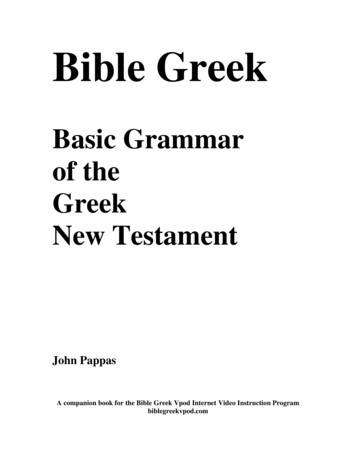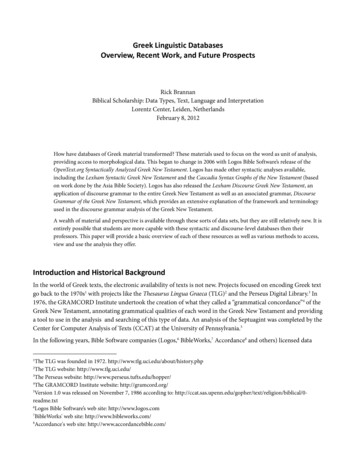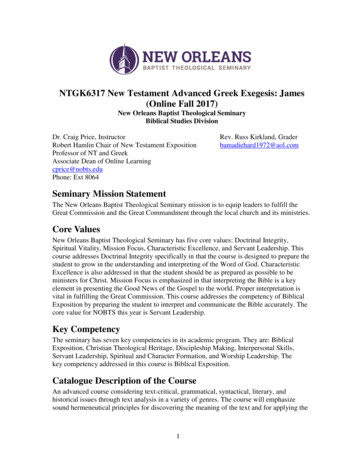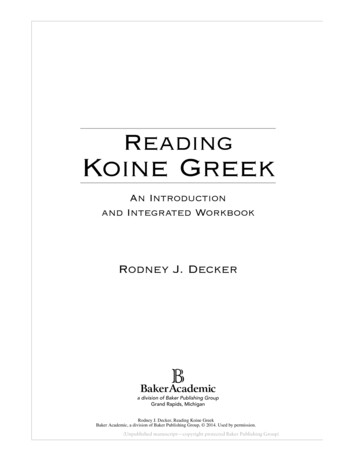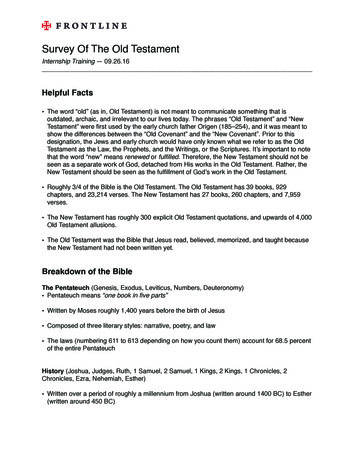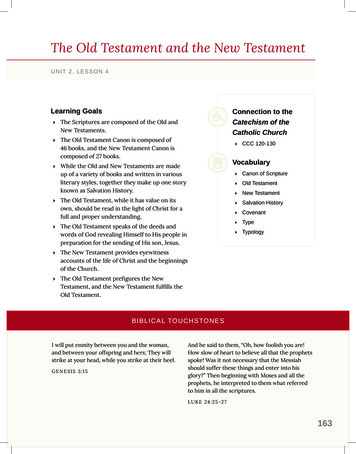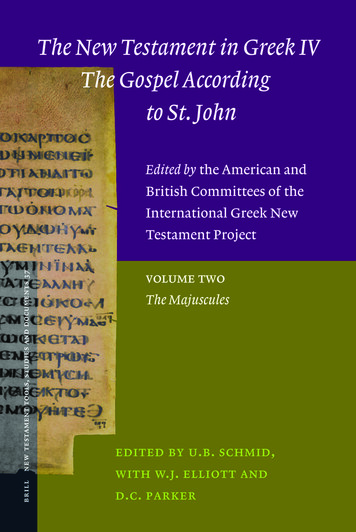
Transcription
The New Testament in Greek IVThe Gospel According to St. JohnVolume TwoThe Majuscules
New Testament Tools,Studies and DocumentsEdited byBart D. Ehrman, Ph.D.James A. Gray Professor of Religious StudiesUniversity of North Carolina at Chapel HillandEldon J. Epp, Ph.D.Harkness Professor of Biblical Literature Emeritus andDean of Humanities and Social Sciences Emeritus,Case Western Reserve University, Cleveland, OhioVOLUME 37
The New Testament in Greek IVThe Gospel According to St. JohnEdited byThe American and British Committees of theInternational Greek New Testament ProjectVolume TwoThe MajusculesEdited byU.B. Schmid, with W.J. Elliott and D.C. ParkerLEIDEN BOSTON2007
This book is printed on acid-free paper.Library of Congress Cataloging-in-Publication DataA C.I.P. record for this book is available from the Library of Congress.ISSN 0077-8842ISBN 978 90 04 16313 3Copyright 2007 by Koninklijke Brill NV, Leiden, The Netherlands.Koninklijke Brill NV incorporates the imprints Brill, Hotei Publishers,IDC Publishers, Martinus Nijhoff Publishers and VSP.All rights reserved. No part of this publication may be reproduced, translated,stored in a retrieval system, or transmitted in any form or by any means, electronic,mechanical, photocopying, recording or otherwise, without prior written permissionfrom the publisher.Authorization to photocopy items for internal or personal use is granted byKoninklijke Brill NV provided that the appropriate fees are paid directly toThe Copyright Clearance Center, 222 Rosewood Drive, Suite 910,Danvers, MA 01923, USA.Fees are subject to change.printed in the netherlands
CONTENTSCommittees of The International Greek New Testament Project viiAbbreviationsixIntroduction1The individual transcriptions and their use in the edition7Summary of material in the printed and electronic editions30The Base Text32The Apparatus Criticus33Dates of the ratus Criticus187PlatesList of platesThe plates555557
COMMITTEES OF THE INTERNATIONAL GREEK NEW TESTAMENTPROJECTThe following members have served on the committees in the course of thisedition:1. The British CommitteeP.H. Burton (2001 to date)J.K. Elliott (1977 to date; Executive Editor 1977–87; Secretary 1987 to date)W.J. Elliott (1980 to date; Co-Editor 1987 to date)†C.P. Hammond Bammel (1990–5)H.A.G. Houghton (2006 to date)J.L. North (1975 to date; Treasurer 1996 to date)D.C. Parker (1984 to date; Co-Editor 1987 to date)T.S. Pattie (1972 to date; Secretary 1976–87; Treasurer 1976–96; Chairman1988 to date)U.B. Schmid (2006 to date; Co-Editor 2003 to date)J.D. Thomas (1990 to date)C.M. Tuckett (2001–6)P.J. Williams (2004 to date)2. The American CommitteeA. Anderson (2005 to date)J.A. Brooks (1988–98; Secretary pro tem 1994–5)B.D. Ehrman (1988 to date; Chair 2004–6)E.J. Epp (1968 to date)G.D. Fee (1970 to date; Chair 1988–2000)T.C. Geer, Jr. (1988–94; Secretary 1988–94)K. Haines-Eitzen (2000 to date; Chair 2006 to date)M.W. Holmes (1988 to date; Editor 1988 to date; Executive Chair 1995–2000;Chair 2000–4; Secretary 2005 to date)P.R. McReynolds (1965 to date; Corresponding Secretary/Secretary 1965–88)M.B. Morrill (1992 to date)R.L. Mullen (2005 to date)C.D. Osburn (1988–2002; Vice Chair 1988–95; Secretary 1995–2001)†W.L. Petersen (1989–2006)J.-F. Racine (2005 to date)3. The Contributors to the TranscriptionsDr D. CreeseDr W.J. Elliott
viiiDr P.M. HeadProfessor K. Haines-EitzenMrs R. KevernDr R.L. MullenDr J.L. NorthProfessor C.D. OsburnProfessor D.C. ParkerMr T.S. PattieDr U.B. Schmid†T.C. SkeatProfessor J.D. ThomasDr G.A. WeirCOMMITTEES
ABBREVIATIONSAmélineau, NoticeE. Amélineau, Notice des manuscrits coptes de la Bibliothèque nationale(Notices et extraits 34, 2), Paris, 1895, 366–9, 380–99ANTF Arbeiten zur neutestamentliche TextforschungAPFArchiv für PapyrusforschungGregory, TextkritikC.R. Gregory, Textkritik des Neuen Testamentes, 3 vols., Leipzig, 1900–9INTFInstitut für Neutestamentliche Textforschung, MünsterJTSJournal of Theological Studies ovTNovum TestamentumP. Oxy. Oxyrhynchus Papyri, London, 1898–Tischendorf, Anecdota:Anecdota Sacra et Profana, Leipzig, 1855Tischendorf, Mon Sac 1846C. Tischendorf, Monumenta Sacra Inedita, Monumenta Sacra Inedita,Leipzig, 1846Tischendorf, Mon Sac volume numberMonumenta Sacra Inedita (Nova Collectio), 7 vols., Leipzig, 1855–70Tischendorf, NotitiaC. Tischendorf, Notitia editionis codicis Bibliorum Sinaitici, Leipzig, 1860Treu, Handschriften in der UdSSRK. Treu, Die griechischen Handschriften des Neuen Testaments in der UdSSR;eine systematische Auswertung des Texthandschriften in Leningrad, Moskau,Kiev, Odessa, Tbilisi und Erevan (TU 91), Berlin, 1966TUTexte und UntersuchungenZNWZeitschrift für neutestamentliche Wissenschaft
INTRODUCTIONTHE decision to break up the task of compiling an edition of the Gospel ofJohn in stages has proved to be of even greater benefit than the editors hadanticipated, since it has allowed us to make full use of developments ineditorial methods and tools. The volume of transcriptions, plates andapparatus containing the papyri, published in 1995, was produced with atechnology which we subsequently abandoned.1 Two events shaped theyears leading up to the completion of this volume. Both occurred in 1997, atthe Society of Biblical Literature meeting in San Francisco. The first was thepresence at the meeting of the North American Committee of theInternational Greek New Testament Project of Professor Barbara Aland,Director of the Institut für neutestamentliche Textforschung, Münster, andtwo of her colleagues, Dr Gerd Mink and Dr Klaus Wachtel. At this meetingvarious traditional differences in approach, and the possibility ofcollaborating were fully discussed. The second event was our first encounterwith Dr Peter Robinson and Collate, the automatic collation program whichhe had developed for transcribing and collating manuscripts of TheCanterbury Tales. The possibilities afforded by Collate have completelyaltered the way in which we compile our data, and have also made possiblecollaboration between IGNTP and INTF without any loss of identity by eitherorganisation.These advances were consolidated at the Second Birmingham Colloquium on the Textual Criticism of the New Testament, held in April, 1999.An important item at this point was the funding question. This was resolvedby a major grant from the Arts and Humanities Research Board, whichenabled us to finance two researchers and to cover research costs for athree-year period. The Principio Project began in September, 2000.2 Besidesthe two research fellows, the team included two research students andadministrative support. In addition, the United Bible Society funded aresearch fellow to produce a critical edition of the Byzantine text of John.The fellow, Dr Roderic L. Mullen, has made transcriptions of majuscule1D.C. Parker and W.J. Elliott (eds.) The New Testament in Greek IV. The Gospel According to St. JohnEdited by the American and British Committees of the International Greek New Testament Project. VolumeOne The Papyri (NTTS 20), Leiden, 1995.2For further information on the Principio Project, see D.C. Parker, ‘The Principio Project: AReconstruction of the Johannine Tradition’, Filologia Neotestamentaria 13 (2000), 111–18; alsopublished in The New Testament Text in Early Christianity (Histoire du Texte biblique 6), eds. C.-B.Amphoux and J.K. Elliott, Lausanne, 2003, pp. 21–9; ‘The Text of the New Testament andComputers: the International Greek New Testament Project’, Literary and Linguistic Computing 15(2000), 27–41; ‘Through a Screen Darkly: Digital Texts and the New Testament’, Journal for theStudy of the New Testament 25 (2003), 395–411.
2INTRODUCTIONmanuscripts for his edition which have also been used for this edition. Theeditors of this volume are grateful to Dr Mullen for his indispensablecontribution to the work of the Principio Project. The team as it was at firstconsisted ofW.J. ElliottResearch FellowR. KevernResearch Student1M.B. MorrillResearch StudentD.C. ParkerDirectorK. ParkerAdministrative support and proofreaderU.B. SchmidResearch FellowThe IGNTP has always flourished with voluntary assistance, and this hasnot changed through the presence of full-time scholars. A number ofcolleagues, whose names are recorded among the lists of the members of thetwo committees, have contributed to the present work.The Principio Project had two principal remits:1. To complete the task of collecting and making available the textualvariation in the majuscule manuscripts.2. To collect sufficient data to be able to analyse the textual character ofthe Byzantine manuscripts and to assess them.The second of these falls outside the present description. It is worthobserving, however, that Bruce Morrill’s responsibility has focused on this.At an early stage in the project, it was decided that a formal agreementbetween the IGNTP and INTF would be of benefit, and a document wasdrawn up. Collaboration in the majuscule volume has included the followingimportant features: discussion and agreement of protocols in makingelectronic transcriptions, in particular tagging features and the discussionof priorities; generosity by INTF in allowing the team access to photographs,microfilms and (in the case of manuscripts in the Bibelmuseum) originals.One of the Principio Project’s microfilm readers was shipped to Münster toreduce pressure on the Institut’s resources. Reciprocally, the Project’stranscriptions were made available as a resource for the production of thedigital Nestle-Aland. Through a series of seminars, conferences andmeetings in Münster, Birmingham and Leicester, members of IGNTP andINTF have discussed many aspects of digital editing and New Testamenttextual work. We believe that this exciting collaboration has made asignificant contribution to the development of our discipline.The majuscules have been divided into two categories for the presentexercise:21R. Kevern subsequently changed the focus of her research and withdrew from the team. Hercontribution to the current volume was still significant.2For the use of the term majuscule rather than uncial, see D.C. Parker ‘The MajusculeManuscripts of the New Testament’, The Text of the New Testament in Contemporary Research.Essays on the Status Quaestionis (Festschrift for B.M. Metzger), ed. B.D. Ehrman and M.W.Holmes, Grand Rapids, 1995, pp. 22–42 (22). The author’s colleagues have, with uniformly goodgrace but varying degrees of conviction, accepted his arguments.
INTRODUCTION3Category 1. Those which are fragmentary and difficult to read.Category 2. Those which are either complete or extensive or, even if theyare fragmentary, are easy to read.The two media in which they are presented contain them in differentways:The website contains complete transcriptions of all witnesses, and anapparatus criticus.The book contains complete transcriptions of all Category 1.manuscripts, with plates of those for which a plate is useful, and anapparatus criticus.It is important to recognise the significance of the transition to theelectronic edition. The single most important characteristic is the changefrom collation to transcription. Instead of making a list of variations from abase text, we followed a process which creates a set of complete electronictranscriptions of individual witnesses, from which an electronic collation(apparatus criticus) is generated. The full process of creating the electronicapparatus will be explained. First, Collate itself should be described.It is the creation of the medievalist Peter Robinson, now our colleague inBirmingham in the Institute for Textual Scholarship and Electronic Editing,who devised it for editing The Canterbury Tales. It has subsequently beenexpanded and developed to respond to the demands of various users. Anelectronic editing package, Anastasia, has been created more recently toturn the Collate XML output into electronic and printed books. It is possibleto apply various grouping methods to the collation output, and these will beapplied to the Johannine material separately. The edition is made by thefollowing process:1. An electronic transcription was made of each witness. This is done bytaking an electronic version of a base text, saving it with a file name thatcontains the manuscript’s Gregory-Aland number, and then modifying it ateach place where the text differs from a base text (we used the Oxford, 1873edition into which we had introduced all the most common forms of thenomina sacra), and tagging it as is appropriate. At the beginning of theproject, a good deal of time was spent on preparing a set of procedureswhich dealt in particular with two problems. The first was thestandardisation of data storage, the outline of which is described below. Thesecond was in developing a system of tagging. There was already a set ofguidelines provided by previous users of Collate, but these were not allsuited to the particular requirements of the Greek New Testament. TheMünster Institut began to use Collate for editing the Greek New Testamentfirst, and provided us with a set of rules which we accepted and thenexpanded. The tagging can, in principle, include anything the editor wantsto include in the edition. The most important things to be indicated arefirst-hand readings and corrections, lacunae and restoration of missing text,and layout.
4INTRODUCTIONWe have followed what we call a modular principle. We have certainlynot provided transcriptions that are exhaustive with regard to layout, butthey all include folio, column and line layout. Of course the original text andsubsequent corrections are included. Some include indented or hanginglines, and other features as detailed in the paragraphs on the individualmanuscripts below. One great benefit of electronic transcriptions is thatthey can be developed and improved by successive teams of scholars. Whatis described as ‘standard formatting’, which broadly applies to manuscriptsin Category 2, in the descriptions of individual transcriptions below consistsof the following:1. Layout: division of text into folios (with numbers found in the MSgiven), columns and lines.2. Punctuation: upper-case letters indicating enlarged initial letters.3. Orthography: as in the manuscript transcribed, with superline for nuwhen the MS uses it, other abbreviations indicated with brackets (e.g.k(ai) indicates use of the ka compendium), and nomina sacra indicatedby a superline over the second letter of the contraction. Note that we usethis superline as an indication of the nomen sacrum, and not as areproduction of precisely what is in the manuscript. Thus it is presenteven when it is omitted by the copyist. This represents a difference fromour practice in the papyrus volume. The change has been made in orderto allow the program to recognise all readings in this category.4. Original text and subsequent corrections are all shown, with thefollowing sigla:*the text as first written by the original handC*a correction made by the original handCa correction by another hand. C1 or C2 is used where morethan one correction is madeOther sigla are indicated in the descriptions of individual transcriptions.Where the first hand (or a correction) is illegible, we enter the number orprobable number of letters. For example, see the reading of 02 at 4.19.Note that in the printed transcriptions, corrections to manuscripts aregiven in the footnotes, the corrected text being in italics.5. Lacunae: missing text is indicated by these signs:lacparchment is missing and the text is lost (this includesplaces where the parchment is present, but the text cannotbe read); where the parchment is lost, and has beenreplaced, the text has been transcribed in a separate file[ c] restoration of missing text is given in brackets. Sometimeswe give a number or range of numbers in square brackets c dots under letters indicate that the restoration of the text isuncertain6. Superscription and subscription are provided when present.All these features are present in the printed transcriptions. The layout ofthese transcriptions places line numbers on the left and verse numbers on
INTRODUCTION5the right, except for two-column manuscripts, when the line numbers are inthe centre with the verse numbers in the outer margins.Manuscripts in Category 1 have been transcribed with the highestpossible level of representation of all that is visible. In practice, this willvary depending on the parts of a leaf that are extant (e.g. lack of margins toshow original line breaks, presence of page numbers or running titles,uncertainty over use of nomina sacra in small fragments).2. Once a transcription was complete, each individual transcription wascollated against a base text. Some of the transcriptions have a history whichpredates Collate, and a description of the process followed for eachmanuscript is provided below. This preliminary collation provides anopportunity to remove any tagging errors, since the program produceserror messages when it detects inconsistencies. These were saved on theproject’s server as ‘Level1’ files.3. The collation of two independent transcriptions of a witness led to theverification of the discrepancies, and the revision of one of them into atextually accurate ‘Level2’ file. Both of the Level1 files were archived in a‘Transcription Store’, so that any queries about changes could later betraced back to their source.4. During the process of the Principio Project, various changes in taggingprocedures had to be taken into account. At the final stage, transcriptionswere checked to make sure that they were up to date and then became‘Level3’ files.5. Once all the transcriptions were available, initial collations of all ofthem were run which again threw up various error messages.6. The next two stages determine the variants to appear in the apparatus.First is ‘Regularisation’, the process of suppressing differences betweenwitnesses which were not to be included in the apparatus. Part of this wasdone by ‘Fuzzy Match’, making superline for final nu equivalent to final nu,equating upper- and lower-case letters, and so forth. We have regularisedthis apparatus very lightly. A heavy regularisation would exclude allorthographical variants. Since full information about such details is animportant justification for the present volume, they are retained.7. The second part of this stage of the process is ‘Set Variants’. Theprogram inevitably presents variants in a way that is sometimes inadequate.Setting variants determines the length and thus the content of variantreadings. The application of these tools has the result that a singletranscription may lead to somewhat different presentations in twocollations, depending on the readings of other witnesses cited and theeditor’s decisions. Users may therefore expect to find the readings ofwitnesses being presented differently in this edition and in the Byzantinetext of John, although the same transcriptions were used by each.8. Once this has been done, the text is output as XML into Anastasia. Nowthe tagging will be used to determine the format of the published editions.For the printed edition, the XML was edited using Tex to produce a pdf.
6INTRODUCTIONThis introduction should conclude with thanks to many people. The IGNTPhas always valued its association with a diverse group of contributors. Wemay add to that much greater institutional cooperation. Above all, thePrincipio Project has provided a framework for highly enjoyable and fruitfulcollaboration with the Münster Institut. Our thanks go first and foremost toProfessor Barbara Aland, whose courage and foresight made all this possible,and whose hospitality on visits to Georgskommende has made it possible toaccess material which would otherwise have been unavailable. It was in myhouse in Birmingham in 1999 that she gave us a vision of how much morecould be done by securing major funding, and inspired us to achieve it.Other colleagues also provided valuable assistance: Michael Welte withinformation about libraries and manuscripts; Klaus Wachtel has been anexperienced and wise guide in many matters, and has always been agenerous colleague.In a series of seminars and private meetings in Münster and elsewhere,we have been able to discuss and develop our theories about many aspectsof textual editing. Many of these meetings were attended by Prof. P.M.W.Robinson and other colleagues from the Centre for Technology and the Artsand the Stemma Group, and we have been able to exchange our ideas witheditors of other kinds of texts. Peter himself has responded patiently to ourfrequent queries, stimulated our thinking, and developed Collate accordingto our often heavy demands.Finally, as Director of the Principio Project, I record my appreciation ofmy colleagues for three remarkable years, which have been as fruitfulthrough their high abilities as they have enjoyable through theircolleagueship.D.C. ParkerInstitute for Textual Scholarship and Electronic EditingUniversity of BirminghamJanuary, 2007
THE INDIVIDUAL TRANSCRIPTIONS AND THEIR USE IN THE EDITIONThe treatment of particular manuscripts has varied, both in the development of our transcriptions and in the use that we have made of them. Adescription of the majuscule manuscripts of John included in the Liste1 andthe decisions we have made follows.01 (a)London, British Library, Add. 43725CompleteAn initial paper collation was made from the Lake facsimile in 1985–6.2 Anumber of uncertain readings were established from the manuscript. Thiswas revised by T.C. Skeat in 1996, who used his memory and extensive notesmade by himself and Milne when they were examining the manuscript afterits arrival in London. Amy Myshrall made use of this in her dissertationwritten for a master’s degree at the University of Birmingham, and alsochecked a number of uncertain places in the manuscript.3 All of thismaterial was used to make an electronic transcription when we began usingCollate. It was automatically collated with the INTF electronic transcription,and all discrepancies were reconciled from the facsimile. We are grateful toLuc Herren, Marie-Luise Lakmann and Klaus Witte for their contributions.Some final checks were made by Rachel Kevern, using the digital imagesmade for the Codex Sinaiticus Project.The designation of correctors follows the schema presented by Milne andSkeat.4 The precise application of them was made by Skeat himself. Thecorrectors found in John are:S1Scriptorium hand5S2Scriptorium handCcaFifth to seventh centuries 6 or from seventh century7CcbFifth to seventh centuries or from seventh centuryCcb2Fifth to seventh centuries or from seventh century11K. Aland with Michael Welte, Beate Köster and Klaus Junack, Kurzgefasste Liste der griechischenHandschriften des Neuen Testaments (ANTF 1), 2nd edn, Berlin, 1994. Updates available . and K. Lake, Codex Sinaiticus Petropolitanus, 2 vols., Oxford, 1911–22.3Amy Catherine Myshrall, ‘The Gospel of John in Codex Sinaiticus’, unpublished M. Phil. thesis,University of Birmingham, 2000.4H.J.M. Milne and T.C. Skeat, Scribes and Correctors of the Codex Sinaiticus, including contributions byDouglas Cockerell, London, 1938.5Milne and Skeat, op. cit., p. 656Milne and Skeat, loc. cit.7K. and B. Aland, The Text of the New Testament. An Introduction to the Critical Editions and to theTheory and Practice of Modern Textual Criticism, 2nd edn, Grand Rapids and Leiden, 1989, p. 108.
8THE INDIVIDUAL TRANSCRIPTIONSThe transcription contains standard formatting, quire signaturesrunning titles, punctuation and accentuation.The transcription is provided on the website,2 and the manuscript isincluded in the apparatus.02 (A)London, British Library, Royal 1 D.VIII1.1–6.50; 8.52–21.25 (small lacuna at 13.21)A paper collation was made from the reduced collotype facsimile3 in theyears 1986–8. A number of uncertain readings were established from themanuscript. A second collation from the facsimile was made in 2000. Bothcollations were made into electronic transcriptions in 2001. These wereautomatically collated with the INTF transcription, and all discrepancieswere reconciled either from the facsimile or from the manuscript. We aregrateful to Luc Herren, Marie-Luise Lakmann and Klaus Witte for theircontributions.The transcription contains standard formatting. Correctors aredesignated C1 and C.The transcription is provided on the website, and the manuscript isincluded in the apparatus.03 (B)Vatican, Bibliotheca Apostolica Vaticana, Gr. 1209CompleteA collation from microfilm was made in 1999. It was made into a Collatetranscription in 2001. An electronic transcription was made from the mostrecent facsimile edition.4 They were automatically collated with the INTFtranscription, and all discrepancies were reconciled from the facsimile. Weare grateful to Luc Herren, Marie-Luise Lakmann and Klaus Witte for theircontributions.The corrections we have included are C1 (contemporary with the firsthand) and C2 (generally dated to about the sixth century5). As is well known,this manuscript was retraced at a late date. The hand responsible for thismade many slight alterations, in particular by not retracing lettersconsidered otiose, such as final nu before a following word beginning with aconsonant and the epsilon in the common spelling . We have not includedthis information in our transcription, on the grounds that while it is aninsight into later taste, it has nothing to contribute to a study of themajuscule tradition of the Gospel of John.The transcription contains standard formatting, running titles,punctuation, including the Vatican paragraphs and spaces within lines, and1Sources as for Cca.www.iohannes.com3E.M. Thompson, Facsimile of the Codex Alexandrinus, 4 vols., London, 1879–83.4Bibliorum Sacrorum Graecorum: Codex Vaticanus B, Rome, 1999.5See e.g. K. and B. Aland, loc. cit.2
THE INDIVIDUAL TRANSCRIPTIONS91accentuation. Larger spaces, showing breaks in meaning, are indicated, asare hanging lines.The transcription is provided on the website, and the manuscript isincluded in the apparatus.04 (C)Paris, Bibliothèque nationale, Gr. 91.3-40; 3.33–5.16; 6.38–7.3; 8.34–9.11; 11.8–14.6; 16.21–18.36; 20.26Codex Ephraemi Rescriptus is a special case. This palimpsest wastranscribed by Tischendorf in an edition which has been established to be ofa high degree of accuracy. We made two separate transcriptions of it inCollate and reconciled them automatically. We also noted differences fromTischendorf in the apparatus of von Soden and Nestle-Aland 27. We could notfind any photographic reproductions which allowed us to improve onTischendorf. The manuscript itself was examined in 2002. We checked everyplace where Tischendorf had recorded a correction.2 Unfortunately, wewere not able to check the entire text.The transcription contains standard formatting. The two correctors aretagged as C1 (contemporary with the first hand) and C2 (generally dated toabout the sixth century3) according to the standard practice. C is used wherewe were not certain which of them was responsible.The transcription is provided on the website, and the manuscript isincluded in the apparatus.05 (D)Cambridge, University Library, Nn.II.411.1-16; 3.26–18.13; 20.13–21.25An electronic transcription (of the Greek only!) was made from thefacsimile in 2001, using D.C. Parker’s notes on the manuscript. A secondtranscription was made in 2002. These were compared automatically, andthe differences reconciled.We follow Parker’s modification of Scrivener’s identification of thecorrectors.4 Correctors appearing in John are, with Parker’s dating:1We also include the horizontal stroke and double point (the so-called ‘bar umlaut’ of P.B.Payne (see Philip B. Payne and Paul Canart, ‘The Originality of Text-Critical Symbols in CodexVaticanus’, NovT 42 (2000), 105–113 (also available at http://rosetta.reltech.org/TC/TC-linksmain.html). We record the horizontal stroke, which denotes a new paragraph.2See also W. Lyon, ‘A Re-examination of Codex Ephraemi Rescriptus’, unpublished Ph. D. Thesis,University of St. Andrews, 1956; id., ‘A Re-examination of Codex Ephraemi Rescriptus’, NTS 5(1958–9), 266–72.3See e.g. K. and B. Aland, loc. cit.4D.C. Parker, Codex Bezae. An Early Christian Manuscript and its Text, Cambridge, 1992, pp. 35–49,293–4; F.H. Scrivener, Bezae Codex Cantabrigiensis, being an exact copy, in ordinary type, of thecelebrated uncial Graeco-Latin manuscript of the Four Gospels and Acts of the Apostles, written early inthe sixth century, and presented to the University of Cambridge by Theodore Bezae, A.D. 1581,Cambridge, 1864 (reprinted, Pittsburgh, 1978). See also J.R. Harris, Codex Bezae, a Study of theso-called Western Text of the New Testament (Texts and Studies Vol. 2, No. 1), Cambridge, 1891; TheAnnotators of the Codex Bezae (with some notes on Sortes Sanctorum), London, 1901.
10THE INDIVIDUAL TRANSCRIPTIONSABC400–440fifth centuryfifth century (note, C for this MS represents this corrector, and isnot a siglum meaning ‘Corrector’)Dc. ates correction which cannot be attributed to a specific hands.m. used broadly in the same way as K, but includes corrections aboutwhich Scrivener was too specificThe transcription contains standard formatting, running titles,punctuation including spaces and hanging lines, and diacriticals (principallydiairesis).The transcription is provided on the website, and the manuscript isincluded in the apparatus.07 (E)Basel, Universitätsbibliothek, AN III 12CompleteA collation from microfilm was made before we adopted the Collateprogram. This was made into an electronic transcription, and a secondtranscription was made. These were compared automatically, and thedifferences reconciled. The transcription is provided on the website, and themanuscript is included in the apparatus.The
Amphoux and J.K. Elliott, Lausanne, 2003, pp. 21-9; 'The Text of the New Testament and Computers: the International Greek New Testament Project', Literary and Linguistic Computing 15 (2000), 27-41; 'Through a Screen Darkly: Digital Texts and the New Testament', Journal for the Study of the New Testament 25 (2003), 395-411.


